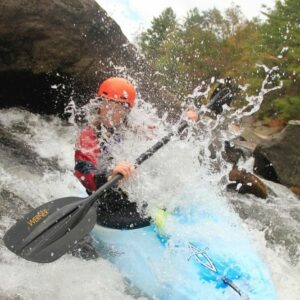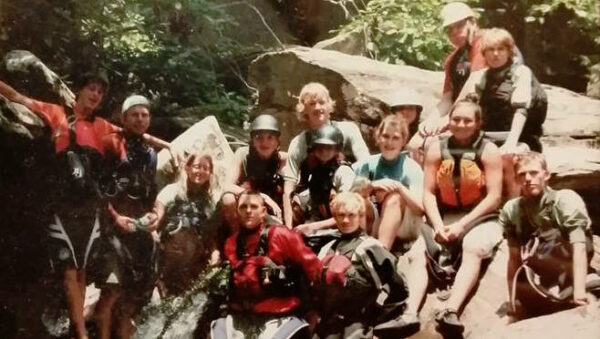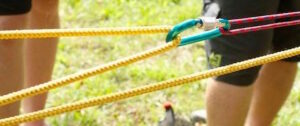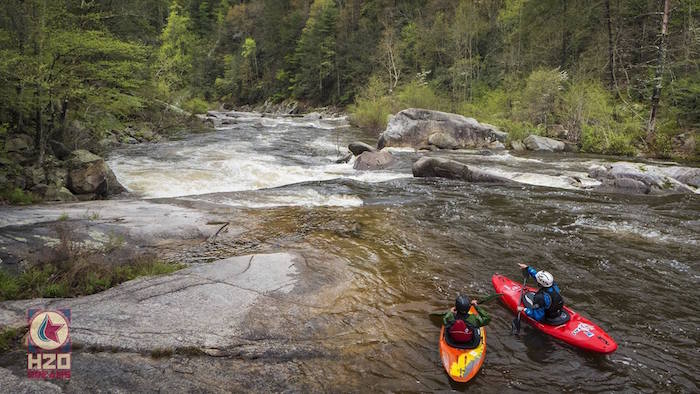It seems to be one of the most common questions I receive from a parent as their child progresses as a whitewater paddler. Actually, more so than “Should my kid be running class V?” I hear, “Is my child ready for this river?” With that, I see an upward trend of moving young paddlers closer and closer to class V the longer I teach children, and I think it is due time to have the public discussion of what is appropriate and necessary for youth as they progress as paddlers at a radical rate. It’s both an exciting and terrifying prospect all at once.
What’s the problem?
So why is this even a question? As I stated before, children are progressing at an astounding rate due to a variety of factors. Access has become easier, both for boats and venues to learn, and with it, more educational programs are readily available to get your child moving in the right direction. Children are, without a doubt, quicker kinesthetic learners as they are still developing their cognitive experiences and do not have nearly the number of hesitations as adults do due to life experience i.e. they are more likely to be ok with failure, and failure is a critical part of the learning process. Their motivation is simple: as long as it looks cool, fun, and seems safe, they’ll dig it. All of these things lower the barriers of learning we often encounter as adults as we are trying to get new folks into the sport. Simply put, kids are generally easier to teach and, as a result, progress faster than (most) adults.
This is seemingly a winning formula for your child’s long term success in whitewater kayaking, but with the above successes lie the many caveats that are often overlooked during the teaching progression as it is possible the child is not quite mature enough to understand the consequence of what we do at the class IV-V level of kayaking. The risks we take are enhanced at this level of kayaking, though statistics suggest the risk of something catastrophic are much lower than what we perceive, even at the highest level with the necessary skills in place. The fundamental physics of the kayaking are no different from class nothing all the way to class V. However, the time in which we have to execute skills and the objective and subjective factors of risks all skew heavily toward brain overload as we move along the spectrum towards class V. Rarely is the problem for the youth an inability to execute the kinesthetic skills to keep physics our friend, rather, it is understanding the objective and subjective risks where things can go wrong for them i.e. environment, decision making, experience recognition, group dynamics, and risk management.
Examples of Objective Hazards
- Swift, complex water
- Sieves and undercuts
- Flooding
Examples of Subjective Hazards
- Complacency
- Overconfidence or hubris
- Distraction
How did this become a problem?
I feel this has become more of a systemic issue which has lead us to this to this dilemma of having to answer if our children are ready for class V as opposed to the individual child knowing themselves, as we have extrinsically motivated children instead of taking the time to give them an intrinsic understanding of motivation. Whoah! What’s with the big words? Take a moment to understand the difference between the two and we will continue on.
Intrinsic Motivation – stimulation that drives and individual to adopt or change a behavior for his or her own internal satisfaction or fulfillment.
Extrinsic Motivation – drive to action that springs from outside influences instead of from one’s own internal feelings.
 The majority of our kayak marketing spends less time on the importance of what the sport means to us individually and instead puts the focus on how it makes us look to the rest. Some of this is also due to the advent of social media but regardless, this is a dangerous paradigm as it can easily influence your child’s decision making matrix; instead of looking at the objective and subjective risks involved with the river, they are purely thinking of what will be the rewards of success. Let me state that this is a completely normal and acceptable response as it keeps a paddler’s motivation alive and well, but it certainly puts the cart before the horse by only giving ownership of the rewards and not ownership of the processes involved to get there which include individual views of fear, personal skill assessment, performance, our view of ourselves within the group, and so on.
The majority of our kayak marketing spends less time on the importance of what the sport means to us individually and instead puts the focus on how it makes us look to the rest. Some of this is also due to the advent of social media but regardless, this is a dangerous paradigm as it can easily influence your child’s decision making matrix; instead of looking at the objective and subjective risks involved with the river, they are purely thinking of what will be the rewards of success. Let me state that this is a completely normal and acceptable response as it keeps a paddler’s motivation alive and well, but it certainly puts the cart before the horse by only giving ownership of the rewards and not ownership of the processes involved to get there which include individual views of fear, personal skill assessment, performance, our view of ourselves within the group, and so on.
Further, many of our current educational programs promote the idea of individual development and less of a team dynamic for success. Certain disciplines in kayaking, especially those in line with competition, leave out the most important facets of expedition behavior we experience at a high level of paddling. There are virtues to all disciplines of paddling and we should be continually seeking to become balanced paddlers so that we can be a resource to others within our community and offer leadership to other newcomers. Pulling from the resource of skills of each discipline, understanding how they overlap, and adopting old techniques and creating new techniques ensures a well balanced paddler for the long term.
Expedition Behavior – the ability to communicate effectively, participate fully, and tolerate adversity and uncertainty within a team.
What are the specific areas that are being left out in children’s kayak education?
Leadership
Most children are solely being led on rivers; it’s natural. They are still being nurtured in life to make the best decisions possible and they also learn exceptionally fast and well by following and emulating those that become their role models. The issue with this is that in most outdoor sports we are rarely dealing with absolutes and are instead playing with an often fickle and ever-changing environment. Not only is the environment constantly changing but as is the group experience and dynamic as we move downstream. Leadership often changes hands due to logistical necessity or separation. A child in class IV and V will have to be able to not only make his/her own decisions but may have to make a very important group decision as well in a timely fashion. This is a lesson that not only children need to learn but also for those that are teaching children and others. This is easily the most often overlooked skill when it comes to whitewater kayaking.
Individual and community responsibility

As paddlers, we not only have an environmental responsibility but a responsibility to our self image and community image as well by having pride in ourselves and our culture. We also have a duty to one another to communicate effectively and to ensure we all come back from every experience not only physically but mentally as well.
Understanding risk management
Risk is our exposure to hazard or danger, both physically and mentally. There are individual elements and group. We have both concrete hazards as well as subjective pitfalls we face. All of these things work together (or don’t) in an ambiguous state where it is easy to have oversights and make mistakes. These things are further affected by our motivations, frustrations, training, and experience and includes an infinite number of other things. All of this boils down to experience both good and bad and results in maturity.
Understanding and executing rescue skills (and other logistical skills)
 Because of most children’s reliance on one dominant older leader, they have never had to be an active part of a rescue themselves even at the most basic level, such as assisting a swimmer in whitewater. These are actually day to day skills at a class IV and V level .
Because of most children’s reliance on one dominant older leader, they have never had to be an active part of a rescue themselves even at the most basic level, such as assisting a swimmer in whitewater. These are actually day to day skills at a class IV and V level .

Great article, As a former Scoutleader the picture of the large group of youth is frightening. There may be safety in numbers but there’s danger in chaos.
I think you should go ahead and speak more freely about drowning, broken bones, death and that sort of thing. Additionally living with the death of a friend or loved one should be included.
I Agree with this post. Is the guardian or parent willing to accept the death of a loved one on a class IV/V river? Is the parent or guardian willing to accept the fact that the adult their child was with who died or got hurt did everything possible and directed their child in the best way before the accident? Lastly, should able adult kayakers of said class be willing to take minors down said class rivers and be able to live with an accident such as a death of a child? All things to be considered…
Children are small. Can the child be placed in the position of a long nasty swim that even an adult would find dangerous? Skills are great. Experience and judgment are priceless. Don’t push your kids to benefit your ego.
GREAT article Chris! I think you summed up the challenge in your article… not a problem with will or skill, but one of wisdom and group decision-making.
My personal insight…. When I was 12 I was capable of running IV+ and easily moving into V. I was annoying, arrogant, cocky, and I was held back for those very reasons. My parents felt like I should mature before I stepped up to something beyond the Ocoee. By the time I was 16 I got into class IV and V creeking. Beyond the fact that I was cocky and annoying, I don’t see how my friends worked passed my egocentric perspective. I genuinely understood my mortality and I was cautious and even conservative in some of my decisions, but then I was reckless and arrogant in others. It almost got me killed by the time I was 18. Most of us who’ve been around, over 20 years for me, have lost friends or pulled someone out who didn’t wake back up…or been there for the recovery… it changes your perspective in a way that’s hard to describe.
I think kids are capable of amazing things, but I’m genuinely unsure about kids on class V on a large scale… exceptions certainly exist. I wonder where I’d be if my upbringing wasn’t as conservative (paddling-wise). Would I be as cool Dane Jackson? Or would I be dead? Thinking out loud here… and unsure of the final answer. I would probably try to keep mine on fun, relatively safe class IV+ or V- at the most. You can have a lot of fun and hone a lot of skills on that…. not to mention the benefits of being good at playboating!
Sounds like a great program though!
Looks like an ad for his class to me.